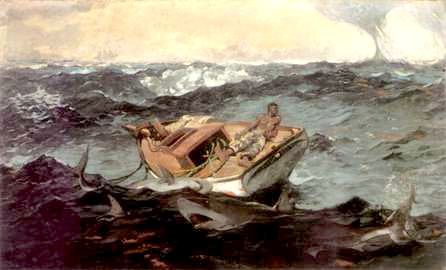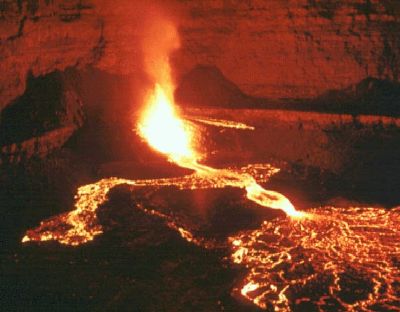by Larry
January, 2004Our Turbulent OrbIn spite of its four-plus billion years of age, our world is still tremendously dynamic. This can be seen in the vast jet streams, seas, and rivers of air that flow past or dramatically into one another, creating exciting local weather fronts, or that churn themselves into huge hurricane systems, devastating tornadoes, or massive monsoons spreading over the Indian and Southeast Asia subcontinent in summer and, breath-like, back out over the Indian Ocean in winter. It can be seen too not merely in the twice daily tidal surges and ebbs but in great river-like ocean currents that retain their separate integrities for thousands of miles, held together and distinct by differences in temperature and salinity, and hence in density. These streams persist without apparent natural channels for tens of millennia. Such currents flow throughout much of the Earth's oceans and are vital in fashioning our climate. Warm ocean currents, for instance, keep the southwestern region of Britain relatively balmy compared with Labrador's frigid experience on the same latitude. The oceans circulate in a complex web of such streams. "Abyssal ocean" rivers begin with "ocean sinks," regions such as the Labrador and Greenland seas where polar winds cool the water surface to even below "freezing" at the same time as expanding sea ice loses the salt its water held before turning from liquid to solid, substantially adding to the surrounding seas' salinity. The cold, salty water is relatively heavy and plummets toward the sea floor. As such rivers or "sinks" move down and away from polar regions, warmer, fresher, and lighter surface "upwellings" flow to take their place in vast ocean rivers such as the Gulf Stream.
For these currents to continue in such cycles, that ultimately involve every ocean and persist through immense periods of time, requires enormous energy. Without it, the system would come to a halt. Frigid, salty waters would, for instance, sink to the bottom and simply stay there. That they do not, but instead eventually are propelled along the sea bottom until turbulently mixed and rising again into upper sea levels, is due to the influence of the Moon, which not only keeps the daily tides moving but these epoch-long oceanic rivers as well. So vast are these currents that, though all of the planet's fresh water rivers carry "just" one million tons a second into the ocean, the discharge per second of but one ocean current, the Gulf Stream, is thirty million tons. These huge flows of water pass each other at different depths like ten thousand mile long freight trains on tracks that lead them up and down the Atlantic, completely around Antarctica, spinning through the Indian Ocean, and looping about parts of the Pacific. Besides the main streams, there is a multitude of smaller ocean rivers that together form an intricate circulatory system and help keep our terribly diverse planetary pattern alive. Scientists are only now learning to model the complex interactions of the turbulent atmospheric and oceanic currents. But the seemingly solid earth has its own dynamism, of course, with vast tectonic plates separating or pressing up against one another as they and the earth's crust float on the molten liquid mantle beneath, creating earthquakes, majestic mountain ranges, the drifting apart or together of continents, and so on. At times the heat and pressure from below becomes too intense and is then released through volcanic fissures and calderas. Occasionally there are colossal transformations following collisions with comets or meteorites. Subsequent to these titanic events, there may be flood basalts, outpourings of lava over enormous areas. But the disruptions under the surface put all of ours above to shame. At Earth's center is a solid core of pure iron as big as the Moon. It rotates, relative to the rest of the planet, about once every 120 years. Surrounding it is a liquid core the size of Mars containing iron mixed with other substances. This region is in continuous flux, the amount of energy and material in motion dwarfing any surface volcanism.
At that boundary, lighter materials condense into slushy sediments. The process of convection activates the entire liquid core. Its turbulent activity, just as with the tides and deep ocean currents, may be accentuated by the influence of the Moon. The more buoyant sediments accumulate over long periods at the CMB into "hills" or "dunes," but may eventually "fall" upward in that boundary's equivalent of avalanches. Disturbed areas at the CMB release cooler iron, that sinks again toward the solid core, while the shifting, mixing, and separating of sediments and liquid under great pressure releases high heat into the mantle, from which periodically there is a volcanic, valve-like penetration of the magma through to the surface.
The full scope of the planet's extreme inner turbulence is, perhaps fortunately, largely beyond our imaginations, though it may not be unrealistic to consider it awesomely hellish. Yet, the forces of this underworld inferno, combined with those of our dynamic air and sea realms, all seem to fit together in ways that make of earth a beautiful and life-sustaining sphere.
Sources: Great Rivers of the Ocean The Truth About Earth's Core |

 It is thought that convection in the outer, liquid core starts as iron crystallizes onto the inner core's surface while lighter elements, such as sulfur, oxygen, and silicon, are excluded from these crystals (much as, at the ocean's surface, salt is excluded from sea water when it crystallizes into ice) and begin to rise toward the core-mantle boundary (CMB), which is 2000 kilometers higher and 1000 degrees C cooler.
It is thought that convection in the outer, liquid core starts as iron crystallizes onto the inner core's surface while lighter elements, such as sulfur, oxygen, and silicon, are excluded from these crystals (much as, at the ocean's surface, salt is excluded from sea water when it crystallizes into ice) and begin to rise toward the core-mantle boundary (CMB), which is 2000 kilometers higher and 1000 degrees C cooler.